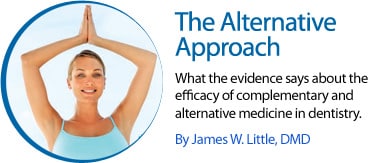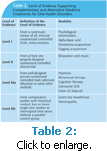
The Alternative Approach
What the evidence says about the efficacy of complementary and alternative medicine in dentistry.
This course was published in the March 2012 issue and expires March 2015. The author has no commercial conflicts of interest to disclose. This 2 credit hour self-study activity is electronically mediated.
EDUCATIONAL OBJECTIVES
After reading this course, the participant should be able to:
- Explain the difference between alternative medicine and complementary medicine.
- Define integrative medicine.
- Discuss how complementary and alternative medicine is used in dentistry.
- Explain the different levels of evidence that support a treatment’s efficacy.
- Identify the adverse effects of herbal medicines when used by dental patients.
Alternative medicine is a broad term used to describe practices used instead of traditional health care.1,2 Complementary medicine, on the other hand, refers to techniques used as adjuncts to conventional medicine.2 The combination of these practices is labeled complementary and alternative medicine (CAM). Complementary and integrative medicine (CIM) combines treatments from conventional medicine with CAM techniques that have high-quality evidence to support their safety and efficacy.3,4
CAM is divided into five major categories:4 alternative medical systems,5-7 mind-body interventions,8,9 biologically-based therapies,10 manipulative and body-based methods,11,12 and energy therapies (Table 1).13 While alternative treatments have varying levels of efficacy, almost half of all Americans have used some type of CAM technique, creating a $30 billion industry.14 Several mind-body interventions, including deep-breathing exercises, meditation, yoga, and acupuncture, rank among the top CAM practices reported by adults in the 2007 National Health Interview Survey (NHIS).4,15 Progressive relaxation and guided imagery were also two of the most popular CAM therapies used by adults.
The use of natural products has also grown considerably in the past few decades.4 The NHIS reported that 17.7% of American adults used a nonvitamin/nonmineral natural product in 2007, with fish oil/omega-3 fatty acid supplements reported as the most common.15 Complementary medicines include herbal medicines, homoeopathic remedies, and essential oils.16-18 Homeopathy involves treating a patient with highly-diluted substances, typically in tablet form, with the goal of stimulating the body’s immune system. The substances are those that would produce similar symptoms as those experienced by the patient if given as a full dose to a healthy individual.16-18
Holistic Dentistry
The principles of CAM have reached private dental practice. Holistic dentistry is based on the idea that oral health and general health are closely connected.19 Holistic dental professionals focus on the whole person supporting physical, social, psychological, emotional, and spiritual well-being.19 The practice of holistic dentistry is focused on health promotion and emphasizes the importance of good dental care; provides lifestyle advice (behavior modification); advises on dietary changes, stress management, exercise, and reasonable sunshine exposure; and integrates appropriate complementary therapies to improve dental and oral health.19
Complementary and Alternative Medicine Therapies Used in Dentistry
Clinical evidence is classified into levels ranging from level I to level V. Level I provides the strongest level of efficacy support and is based on review of all relevant randomized controlled trials and meta-analyses. Level V evidence is the weakest, and consists only of testimonials.19 CAM therapies have varying levels of evidence to support them (Table 2).20 Following is a brief discussion of the evidence supporting the use of CAM therapies in dentistry. .
.
Dental anxiety. High dental anxiety leads to fewer dental appointments and increased oral health problems. The ability of brief relaxation techniques, distraction with music, and virtual image audio-visual eyeglass systems to reduce anxiety in the dental office has been evaluated. Brief relaxation and music distraction were found to be effective at level II.19 Evidence for the eyeglass system was at level IIIa.19 Hypnosis appears to be more effective for children than adults in reducing dental anxiety.
Rapid hypnotic induction techniques appear to be useful for anxious dental patients prior to performing dental procedures. Evidence for hypnosis was at level IIIa.19 In one study, relaxation-oriented therapies (Table 3), cognitive therapy, and nitrous oxide sedation were all found to be effective in reducing dental anxiety scores. Over time, relaxation therapies had the greatest reduction in dental fear measures. Evidence for these effects was at level IIIa.19
Xerostomia. In the treatment of xerostomia, one study found that acupuncture significantly increased salivary flow rates during and after treatment. This beneficial effect was maintained during the following year of observation. In another study, acupuncture increased salivary flow of patients with xerostomia and improved their ability to eat, speak, and sleep. Evidence supporting acupuncture was at a level I.19
Gagging. Three studies have been reviewed that showed acupuncture treatment reduced gagging in dental patients. One study looked at the efficacy of acupuncture for patients who had difficulty with severe gagging during impression-taking, and found that 81% of the patients were able to accept all three stages of impression-taking. Evidence supporting acupuncture was at level I.19,21
Homeopathy. A study of outcome data from 496 patients who received homeopathic treatment revealed a positive outcome in 90.1%, negative outcome in 1.8%, no change in 7.9%, and no outcome reported in 0.2%.22 The most positive outcomes were found in patients with pericoronitis, periodontal abscess, periodontal infection, reversible pulpitis, sensitive cementum, and toothache with decay. Evidence supporting homeopathy was at level IIIc.19
Herbal medicines. Green tea-extract mouthrinses have been used to treat dental caries and periodontal diseases.19 Catechins in the green tea are thought to inhibit acid production of dental plaque. Evidence for this effect is level IIIc.19 Clove oil has been used in dentistry as a topical anesthetic. In a study involving needle sticks and pain response, clove oil and benzocaine gels equally reduced pain scores when compared to placebos.19 Evidence for this effect was level IIIa.
Adverse Effects of CAM Medicines
A number of herbal medicines are used by dental patients for the treatment of medical conditions such as asthma, insomnia, digestive problems, cancer, depression, dementia, heart failure, rheumatologic conditions, schizophrenia, and bipolar disorders. Regardless of whether some of these treatments actually work, the use of herbal medicines can be dangerous.
 Excessive bleeding following invasive dental procedures may occur in patients taking St. John’s wort, saw palmetto, garlic, ginseng, gingko, glucosamine, devil’s claw, and high doses of fish oils. An increase in the sedative effect of anesthetics may occur in patients taking kava kava, hops, valerian, and passiflora. Drug interactions with various herbal medicines and agents used in dentistry may occur. For example, feverfew, ginseng, garlic, ginkgo, and licorice may interact with aspirin and aspirin-containing drugs—increasing the risk for bleeding (Table 4). Ephedra, ginseng, licorice, aloe latex, and senna may interact with corticosteroids.
Excessive bleeding following invasive dental procedures may occur in patients taking St. John’s wort, saw palmetto, garlic, ginseng, gingko, glucosamine, devil’s claw, and high doses of fish oils. An increase in the sedative effect of anesthetics may occur in patients taking kava kava, hops, valerian, and passiflora. Drug interactions with various herbal medicines and agents used in dentistry may occur. For example, feverfew, ginseng, garlic, ginkgo, and licorice may interact with aspirin and aspirin-containing drugs—increasing the risk for bleeding (Table 4). Ephedra, ginseng, licorice, aloe latex, and senna may interact with corticosteroids.
Herbs that affect the gastrointestinal system, such as slippery elm, may slow the absorption of orally-administered drugs. St. John’s wort may interact with a number of drugs used in dentistry.19 Some herbal drugs may also cause oral manifestations. Feverfew can cause aphthous ulcers, lip and tongue irritation, and swelling.
Gingival bleeding has been reported with feverfew and ginkgo use. Echinacea may cause tongue numbness, while St. John’s wort may cause xerostomia and Yohimbe use can lead to excessive salivation. Oral and lingual dyskinesia has been reported with the use of kava, which should not be used during pregnancy.19
Conclusion
Dental health care providers should include a section in the patient’s medical history for noting any herbal medications and over-the-counter drugs. Little education is provided in dental and dental hygiene schools about the use, adverse effects, toxicity, and drug interactions associated with herbal remedies, so it is the responsibility of dental professionals to remain up to date on these issues. The Physicians’ Desk Reference for Herbal Medicines,
Physicians’ Desk Reference for Nonprescription Drugs, Dietary Supplements and Herbs, and Guide to Evidence-based Integrative and Complementary Medicine are all important resources to have on hand. The National Center for Complementary and Alternative Medicine (www.nccam.nih.gov) also provides relevant information.
REFERENCES
- Little JW. Complementary and alternative medicine: impact on dentistry. Oral Surg Oral Med Oral Pathol Oral Radiol Endod. 2004;98:137-145.
- Charlson M. Complementary and alternative medicine. In: Goldman L, Ausiello D, eds. Cecil Textbook of Medicine. Philadelphia: Saunders; 2011:177-184.
- Micozzi MS. Issues in integrative medicine. In: Micozzi MS, ed. Fundamentals of Complementary and Integrative Medicine. St. Louis: Elsevier; 2011:17-27.
- NIH. National Center for Complementary and Alternative Medicine (NCCAM). Available at: www.nccam.nih.gov. Accessed January 16, 2012.
- Ergil KV. Traditional medicine of China. In: Micozzi MS, ed. Fundamentals of Complementary and Integrative Medicine. St. Louis: Elsevier; 2011:373-403
- Zysk KG. Traditional medicine in India: ayurveda and siddha. In: Micozzi MS, ed. Fundamentals of Complementary and Integrative Medicine. St. Louis: Elsevier; 2011:455-468.
- Voss RW. Native American healing. In: Micozzi MS, ed. Fundamentals of Complementary and Integrative Medicine. St. Louis: Elsevier; 2011:531-551.
- Adams P, Fry WP. Humor. In: Micozzi MS, ed. Fundamentals of Complementary andIntegrative Medicine. St. Louis: Elsevier; 2011:189-204.
- Rodgers D, Micozzi MS. Mind-body modalities. In: Micozzi MS, ed. Fundamentals of Complementary and Integrative Medicine. St. Louis: Elsevier; 2011:106-130.
- Micozzi MS. Nutrition and hydration In: Micozzi MS, ed. Fundamentals of Complementary and Integrative Medicine. St. Louis: Elsevier; 2011:355-373.
- Coughlin P. Principles of bodywork: manual and manipulative therapies. In: Micozzi MS, ed. Fundamentals of Complementary and Integrative Medicine. St. Louis: Elsevier; 2011:204-211.
- Redwood D. Chiropractic In: Micozzi MS, ed. Fundamentals of Complementary and Integrative Medicine. St. Louis: Elsevier; 2011:255-274.
- Acupuncture. In: Freeman L, ed. Mosby’s Complementary & Alternative Medicine: A Research-Based Approach. St. Louis: Mosby; 2011.
- Su D, Li L. Trends in the use of complementary and alternative medicine in the United States: 2002-2007. J Health Care Poor Underserved. 2011;22:296-310.
- NIH. 2007 Statistics on CAM Use in the United States. Available at: www.nccam.nih.gov/news/camstats/2007. Accessed January 16, 2012.
- Carlston M. Homeopathy. In: Micozzi MS, ed. Fundamentals of Complementary and Integrative Medicine. St. Louis: Elsevier; 2011:343-355.
- Harris R. Aromatherapy. In: Micozzi MS, ed. Fundamentals of Complementary and Integrative Medicine. St. Louis: Elsevier; 2011:332-343.
- Sierpina V, Gerik SM, Miryala R, Micozzi MS. Western Herbalism In: Micozzi MS, ed. Fundamentals of Complementary and Integrative Medicine. St. Louis: Elsevier; 2011:322-332.
- Kotsinlos V, Vitetta L, Sali A. Oral Health Disorders. In: Kotsirilos V, Vitetta L, Sali A, eds.A Guide to Evidence-based Integrative and Complementary Medicine. Sydney: Churchill Livingstone; 2011:646-694.
- Kotsinlos V, Vitetta L, Sali A. Oral health disorders. In: Kotsirilos V, Vitetta L, Sali A, eds. A Guide to Evidence-based Integrative and Complementary Medicine. Sydney: Churchill Livingstone; 2011:646-694.
- Sari E, Sari T. The role of acupuncture in the treatment of orthodontic patients with a gagging reflex: a pilot study. Br Dent J. 2010;208:E19.
- Mathie RT, Farrer S. Outcomes from homeopathic prescribing in dental practice: a prospective, research-targeted, pilot study. Homeopathy. 2007;96:74-81.
From Dimensions of Dental Hygiene. March 2012; 10(3): 54-56, 59.




